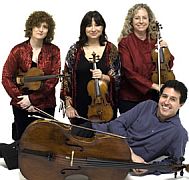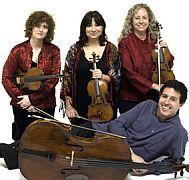
Even as a young composer, Porter knew exactly how to write for strings. Eventually he would write some nine quartets (the exact number is uncertain) that are being revived today. Levitz, the quartet's strong and energetic violist, only recently discovered the manuscripts of the program's four works in an archive at Yale. While these were student compositions, they nevertheless showed a remarkable grasp of Porter's compositional skill, as well as an affinity for string works.
The individual pieces were a "Prelude" (1923); "In Monasterio" (1927), which consisted of three minimovements, all in a medieval style; "Our Lady of Potchav" (1923), a Ukrainian folk song; and "Scherzo" (1923). The Ives Quartet has been recording Porter's complete string quartets, including this concert's featured quartet, which shows the genesis of his American style.
The evening's second presentation, a premiere work by composer Joseph Gregorio, added the baritone voice of Austin Kness to the quartet in a composition titled The Fullness of Peace, a seven-section work honoring Abraham Lincoln. Four of the work's seven sections presented the president's words, while a fifth derived its text from the writings of abolitionist Frederick Douglass. The sixth section, without singer, was a meditation on the Gettysburg Address and the horrors of war, while the seventh was a poem by the composer's sister, Julie Gregorio, that summarized the theme of the first six sections. A composition to honor Lincoln is a wonderful idea. There are few musical works in which we are reminded of his greatness, the most outstanding two accomplishments having been keeping the Union whole and the Emancipation Proclamation. Perhaps Aaron Copland's A Lincoln Portrait is the best-known such effort, but there is room for more.
Text Less Than Clear
The text, printed in the program, offered an opportunity for considerable excitement, but in practice difficulties arose. To begin, the singer's diction was not clear. Part of the time, his voice was covered by the strings, while elsewhere it appeared that he failed to articulate the text with clarity. When, from time to time, the strings were silent, the sung words were clearer. And it is not that the Ives Quartet played too loudly, but rather that there existed some kind of a negative acoustical interaction between the strings and baritone Kness' strong and extremely professional voice. But whatever the cause of the problem, the text, so necessary for this composition's success, was not delivered accurately.An audience should not be required to read the printed text in order to understand what's being sung. Instead, it's the singer's task to make the text crystal clear. The composition itself had some positive moments, but it revealed two significant weaknesses. The first was its length, as could be seen by the number of nodding heads and restless movements from the audience. This failure can be corrected with a disciplined shortening of the work, particularly the fifth and seventh sections. The second problem lay in the entirely monochromatic nature of the composition, with only one orchestral character presented. Even the charming letter to Lincoln from an 11-year-old girl, Grace Bedell, suggesting that he should let his whiskers grow, not only was almost entirely without charm and innocence, but also was presented in the same somber orchestral color as the other six sections. Gregorio must learn the lesson of varying the emotional character of a composition's sections.
Gregorio is a skillful composer, as was shown in the seven sections of the compositions, but he appears not ready or willing to shorten what he writes and present the ideas in a variety of orchestral colors and emotions. This composition is well worth salvaging. It has the essence of a strong work within it, but it needs Gregorio to shape the piece mercilessly to allow that essence to come forth.
The final work of the evening was the "American" String Quartet in F Major, Op. 96, of Antonin Dvořák. Arriving in the U.S. to become the president of the new National Conservatory of Music, Dvořák tried to create a sense of national style through the assimilation of plantation songs, Indian music, and spirituals. The thematic material of this work is not convincingly American. Dvořák displayed brilliance in handling Czech and Hungarian folk songs, though his invented pseudo-American tunes have an awkward character. The Quartet played the work beautifully; it's a fine group. Yet the composition falls between the styles of European classical music and the quasi-Indian and spiritual melodies that Dvořák did his best to invent, or borrow, in order to achieve an American feeling.

